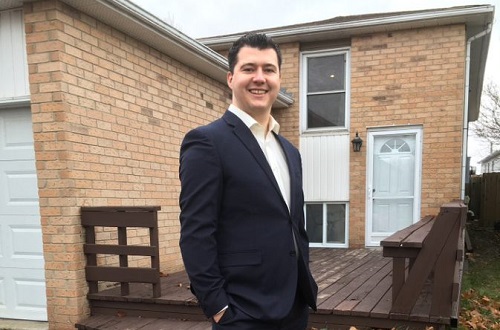Oshawa can be a rough place. Before the GTA gold rush sent investors flocking to the ‘Shwa in search of lower prices and better returns, the only investment most locals saw any value in was money for more cops. In 2014, the city was still mostly known for its problems – unemployment and drugs chief among them – so when 24-year-old Jason Shackleton started talking to his friends and co-workers about getting into real estate as a way to make more money, their reaction was a near-universal: “Here? Now?”
“I was all excited about it – ‘I’m going to change my life and do all these things’ – and pretty much anyone I told that I was going to invest in real estate was kind of like, ‘Now’s not the time to buy a house,’” he recalls. “And I’m looking around thinking, ‘I think this is the best time to buy a house in history.’”
Fast-forward five years, and Shackleton is the owner of three properties in one of the GTA’s most steadfast rental markets. At a time when many millennials are bemoaning the seeming impossibility of getting a toe on the property ladder, Shackleton is living proof that youth and a modest income are no match for optimism and determination.
You snooze, you lose
One thing far rougher than Oshawa is being lost in your early 20s, something Shackleton knows all about. Living with his parents, bouncing from one meaningless minimum-wage job to another, he knew that in order to have control over his future, he would need to lift himself out of the 9-to-5 rut.
“I never really had anything on the side that was making any money for me,” he says. “I was always trying to get that going, but I wasn’t really able to get ahead with it. When I had those lower-paying jobs and was constantly looking for something else, a lot of things were pointing to real estate.”
Shackleton began reading real estate books in his spare time (Flipping Houses for Canadians For Dummies and Richard Kiyosaki’s Cash Flow Quadrant both left a mark). With his knowledge and enthusiasm growing with every turned page, he began believing that real estate was the springboard that would launch him into the next phase of his life. When he landed a full-time job with one of Oshawa’s largest manufacturers, he immediately started setting up meetings with mortgage brokers.
Shackleton was determined to purchase his first property alone – no co-singing, no guarantors. “I just like to take all the risk myself,” he says. “I almost feel like [having a co-signer] is spreading risk on somebody else. I don’t like that.”
He had saved up $30,000 for a down payment, his credit was healthy, and his job looked good on paper, but one of the first questions he inevitably faced was, “Where does your dad work?”
Rather than cave in and bring his parents in to co-sign, Shackleton persisted. “It didn’t really matter,” he says. “I knew that I was going to do this. I didn’t care how many people I had to call. It was going to happen.”
At his third meeting, at a Mortgage Centre in nearby Courtice, a creative broker who believed in Shackleton agreed to fund his first purchase, a small, loveably shabby raised bungalow in Oshawa’s south end that he nabbed for $209,000. After some exhaustive renovations, Shackleton was living comfortably in the top floor, atop his first set of tenants.
“As soon as they signed the lease,” he says, “I used that for the appraisal.”
Shackleton’s willingness to act is a valuable counter-narrative to that of investors who spend years sitting on the sidelines, only to see a fiery market torch their investment dreams. Had he listened to the naysayers and waited until 2015 or 2016 to purchase, he would have been competing with a wave of savvy out-of-town investors who wouldn’t have thought twice about driving the price of his bungalow into the $300s. Late last year, the average price of a detached home in Oshawa was just over $529,000.
“If I had waited, I would still be on the fence,” Shackleton says.
Haste makes waste
One area where Shackleton takes his time, however, is during renovations. His first property required seven months of work before the newly installed basement suite was ready to go; his second, a three-bedroom detached property with an in-law suite that needed a massive overhaul, took two years to complete; and his third, a legal two-unit property located around the corner from his current residence, took a full year of work before it was ready. Those timeframes might shock investors who need cash flow virtually from day one of ownership to make a property pay for itself, but Shackleton is taking the long view.
“I could have [renovated faster], but it wouldn’t have been quality,” he says. “I would have attracted a poorer-quality tenant, the refinance would come in lower because it’s not as nice as some other properties, and if I ever go to sell it, I’m going to get less money for it.”
With his first property cash-flowing and a combination of refinance funds and paychecques keeping him afloat, Shackleton says he had no qualms about putting in the time and work required for perfection. “I don’t care how long it takes,” he says. “I want it to be done so I can get some rental income coming in, but really, the quality is far more important than the actual rental income so long as you can hold onto the property.”
Shackleton’s patience has paid off handsomely. His first property was refinanced at $295,000. His second, which he paid $300,000 for, was refinanced at a stupefying $585,000.
The seriousness with which Shackleton takes his investing belies his youth. By coming to real estate prepared – and prepared to work hard – he makes a lasting impression on his tenants, who, despite being older and more established, respect him as a landlord and have treated his properties like their own.
Well, almost.
“All the signs were there,” he says of his first nightmare tenants. “I could see debt on their credit score. Their credit was awful. But employment was good. I knew that was a problem, and I still picked the person because they had small kids and I felt sorry for them. That was a mistake.”
But by participating rather than procrastinating, Shackleton has put himself in a position where making property management mistakes, and learning from them, is a possibility. Those missteps are a luxury afforded only to people who take action.
Shackleton admits that replicating his success won’t be easy for millennials now that prices have risen sharply and stress tests are in place, but a little determination and creativity goes a long, long way.
“You might have to think differently,” he advises prospective investors his age, suggesting that joint-venturing on and cohabitating in a turn-key property, where only 5% down would be required, might be one of the best ways millennials can still get into the GTA market. After holding their properties until a lucrative refinance becomes an option, these young investors could then start building a portfolio.
Shackleton says he’d “probably be joint-venturing on my first deal” if he were to get started today. “If you really want in, you can get in no matter what,” he says. “There’s always a strategy.”









